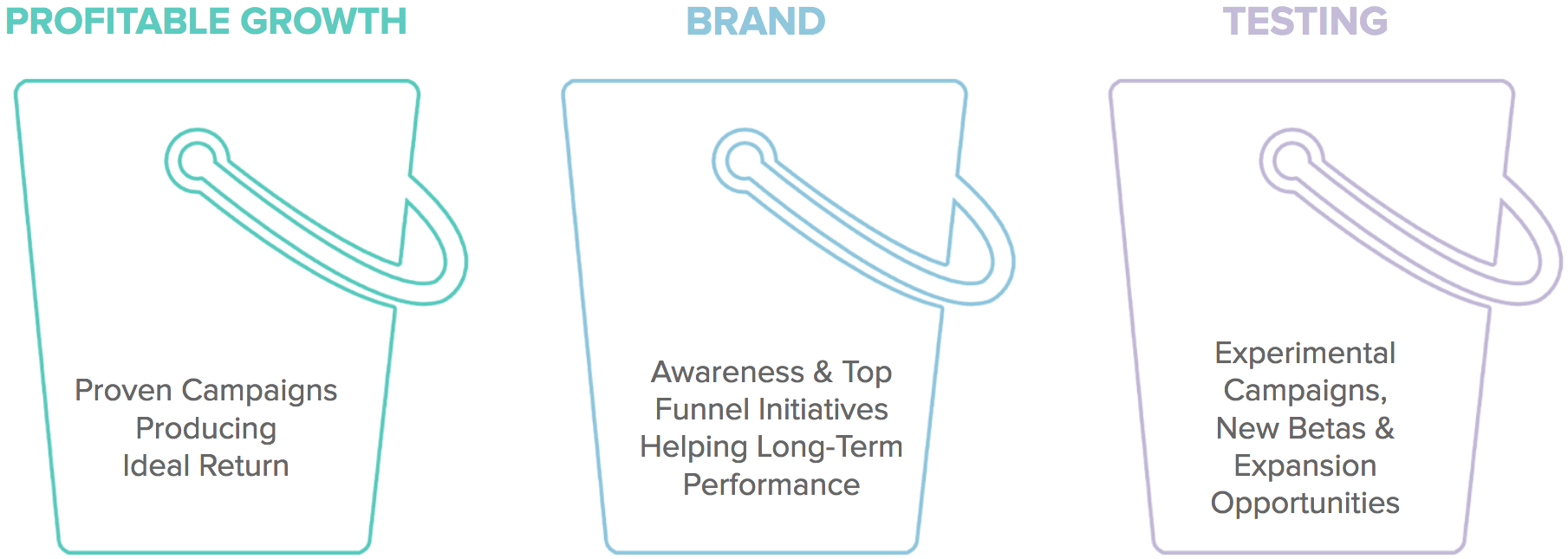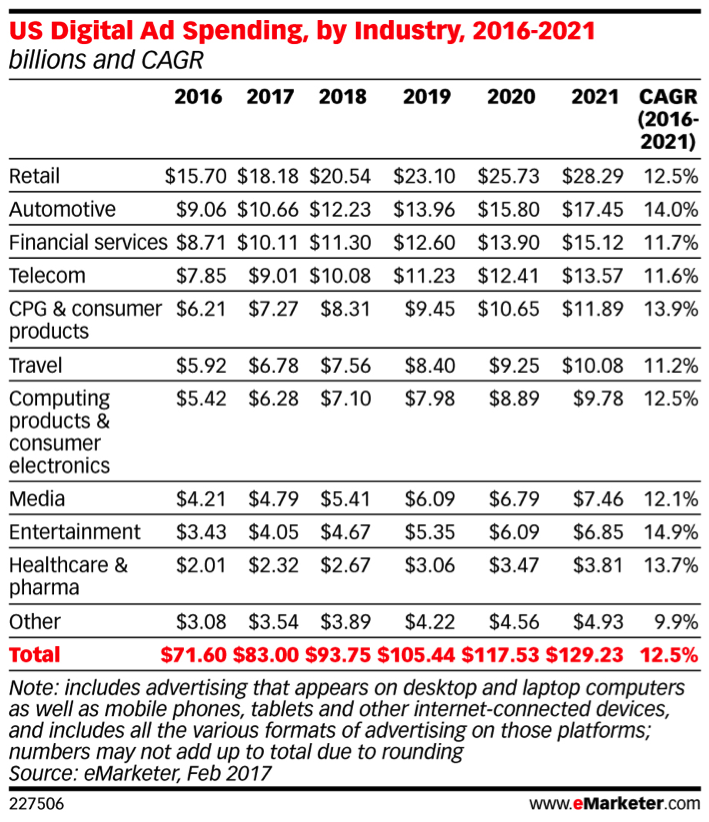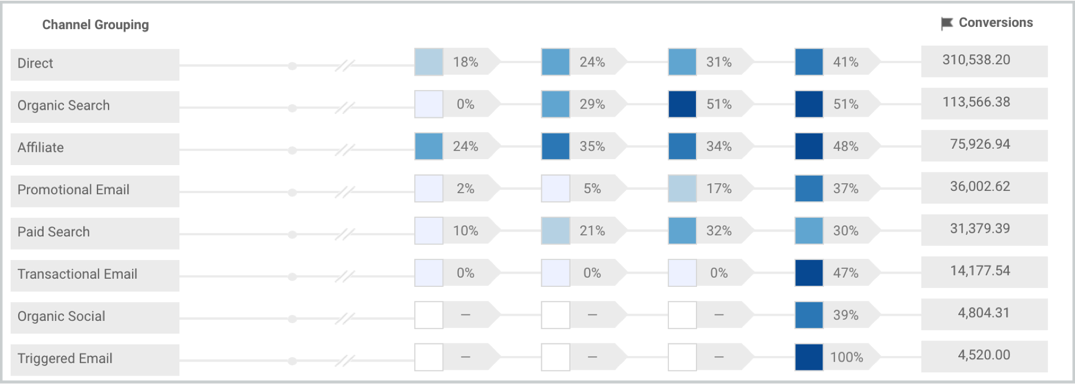When it comes to planning budgets, marketers often aren’t as ambitious as they could — or should — be. They settle for the same results year after year either from a lack of confidence, or a lack of planning. Wpromote believes in a different set of values — values that prize innovation, change, and above all, growth.
We’re already planning 2018 budgets for our clients, and your business should be too if you want to continue to pursue profits that grow year-over-year. Wpromote’s Challenger clients know to expect, and plan to pursue, business growth rather than business stagnation. As a partner, not a vendor, we know our clients’ business goals inside and out and we’re primed to support this growth. With years of experience in building budgets that work, plus tips and learnings from 200 annual planning conversations, we wanted to share our expertise in how you should be building your 2018 marketing budget — and what missteps you need to avoid.
1. Invest In Future Growth
Do: invest in top-funnel initiatives and experimental campaigns
Don’t: invest only in campaigns that produce an immediate expected return
To create sustainable, rapid business growth, businesses must be willing to invest in more than bottom-funnel campaigns that produce an expected return right away. Top-funnel campaigns and experiments are absolutely crucial to finding new prospects and getting those prospects to convert. At Wpromote, we call this budget plan the Three Bucket investment strategy, where budget is placed in three separate buckets: profitable growth (bottom-funnel campaigns), brand (awareness and top-funnel initiatives), and testing (experimental campaigns, betas). All three buckets are necessary to produce growth.

Grow your business through smart investments in all three buckets.
If your marketing budget is the same in 2018 as it was in 2017, then your business will rapidly hit a growth plateau. For example, if you put the same or less investment in SEO, then your competitors may be able to claim real estate on the organic SERPs that should belong to your brand. Your business will be stuck playing defense, instead of taking the offense and claiming market share to own the SERPs. Proper investment in experimental and brand campaigns will keep your brand growing while bottom-funnel campaigns bring in profits.
While not every dollar you put into bucket three will produce a return, you need to be willing to invest those dollars anyway in pursuit of the next big initiative that will work in the first or second buckets. If you never experiment, you’ll never find the winning campaign your business needs to thrive in a highly dynamic world.
2. Exceed Benchmarks
Do: look to exceed growth rates in your industry and peer set
Don’t: let yourself maintain those rates or less, because you’ll fail to grow as a company
It’s important to remember that “growth” isn’t defined by simply adding more dollars to your existing budgets. Spending without wisdom is a shot in the dark at best, and at worst, a waste of money. What all businesses should look to do is exceed benchmarks. This requires discovering the growth benchmarks for the channel(s) you want to use and the competitor(s) you wish to surpass.

Surpass industry and competitor benchmarks to sustain growth and dominate your space. Source.
For example, if the average paid search advertising spend in the US has increased by about 13% year-over-year for the past two years, then a business whose paid search advertising spend is growing at only 8% may believe their budget is invested wisely when in reality, they are actually losing ground to the competition. Growth is relative; even if your budget is growing, you’re still falling behind if you’re not growing relative to your competitors. Plan your budgets to consistently exceed important competitor or channel benchmarks to create continual growth.
3. Leverage CLV Data To Determine Success
Do: look beyond ROAS to CLV
Don’t: look at customers as one-time purchases
It’s tempting to focus solely on ROAS — return on ad spend — when evaluating the returns from marketing efforts. However, ROAS can be a misleading key performance indicator (KPI) when it comes to measuring the returns from middle- and top-funnel efforts such as brand awareness campaigns on social media or prospecting display campaigns. To get a true sense of the value of all your marketing efforts, the most important KPI is customer lifetime value (CLV). A customer with high CLV could be a woman who interacts with your social media messaging, signs up for your email list, tells all her friends about her purchase, and comes back to buy again and again. According to Laura Beaudin, Partner in Bain & Company’s Customer Strategy & Marketing,
“If a customer has a high potential lifetime value, it’s worth pulling out the spending stops to persuade him or her to make a first purchase with the brand. Without that perspective, companies might waste money acquiring low-value customers or targeting prospects who are unlikely to make a purchase.”
While shifting a marketing strategy built on ROAS to one based on CLV may seem like a dangerous strategy in the short term, a CLV focus will create higher returns and greater profits in the long term.
4. Take Advantage Of This Historic Growth Moment
Do: take advantage of historically low capital costs
Don’t: leave opportunity on the table by ignoring capital and loans
In our current economic environment, capital costs are at a historic low. This means that money is cheap — or, to put it more clearly, capital and loans can be secured at historically low rates and be leveraged cheaply to significantly grow your business. According to Michael Mankins from the Harvard Business Review,
“When money is expensive, a dollar today is worth a lot more than a dollar tomorrow – or even the promise of many dollars tomorrow. But when capital costs are low, the time value of money is low. So the promise of more dollars tomorrow (through growth) exceeds the value of a few extra dollars next quarter.”
Simply put, when money is relatively cheap, tomorrow’s dollars are worth more than today’s, making investment in loans and capital worthwhile. Whether or not you choose to take advantage of this economic moment, it’s likely that your competitors will.
5. Rethink Your Attribution Strategy
Do: consider all points and avenues of attribution
Don’t: focus solely on one point (e.g. last click) or risk misattribution
Wise investment doesn’t end when all your campaigns have been launched. Constant manual budget adjustments are the key to making campaigns successful, and to make those adjustments correctly, you need accurate attribution.
Google Analytics defines several different models of attribution, and choosing the right one is important regardless of platform. For example, if you determine attribution for a social media campaign by last click, then you may miss out on the campaign’s true impact: introducing the prospect to your product or service (first click) before they went on to make a purchase at a later point.

Use data-driven attribution to ensure all your results are attributed properly to guide future budget investments. Source.
It’s also important to properly attribute the ways in which digital marketing may influence offline purchase decisions across multiple devices. Consider a scenario like this: your prospect sees your social media campaign on their desktop computer, and it convinces them to travel to a physical store location. There, they make a purchase using a coupon they access through their smartphone’s email client. This multi-touch, cross-device journey needs to be tracked and properly attributed from start to finish.
Correctly attributing the results of all your campaigns is critical to helping you know where you need to increase investments in the future and where you might need to scale investments back when planning your 2018 budget.
6. Key Takeaways
- Think Like A Challenger
- Use the Three Bucket Strategy
- Exceed industry and competitor benchmarks
- Shift marketing to focus on CLV over ROAS
- Take advantage of cheap capital
- Properly attribute all efforts
As mentioned above, growing your budget is not simply about spending more. Investments should be targeted to help you understand who your business’s most valuable customers are, and what they’re worth to you over their lifetime. Most importantly, you need to invest smartly to understand how to get more of the highest CLV customers your business needs to grow.






Responses